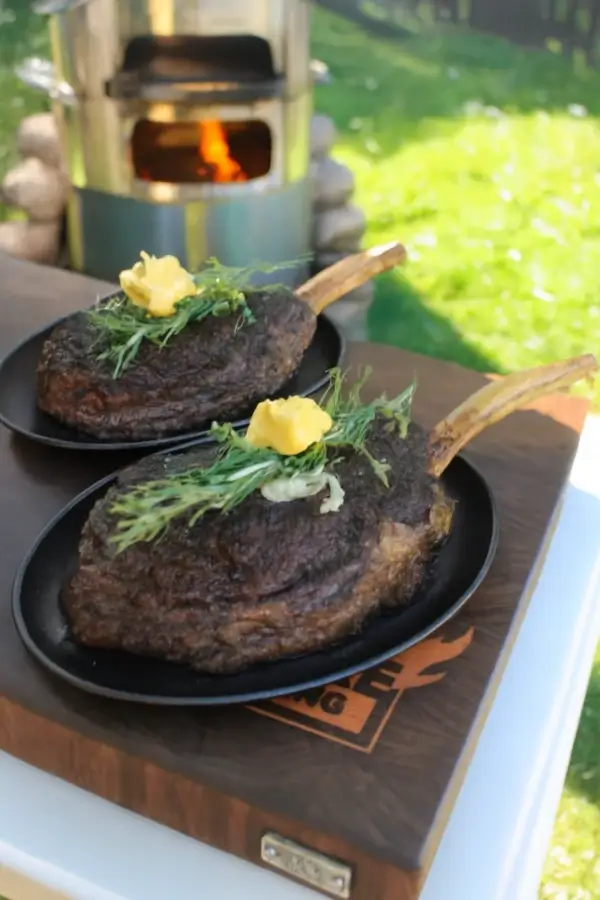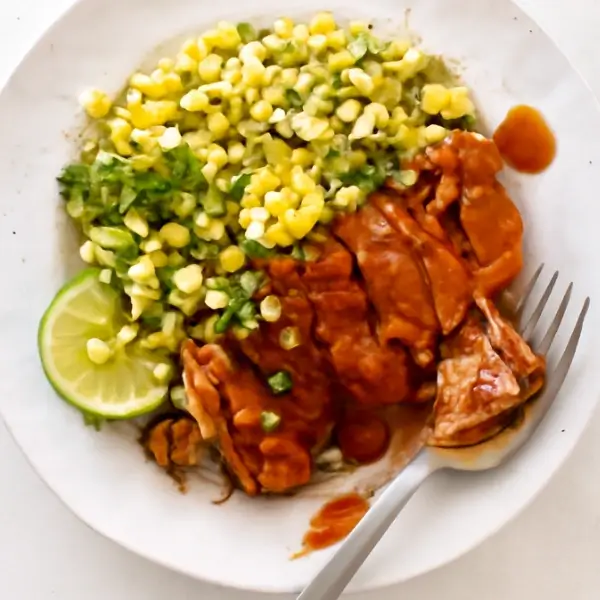If you’re curious about Korean carrot salad, also known as Morkovcha, you’re in for a crunchy, zesty ride through history and flavor. In this article, we’ll cover what makes this dish so beloved, how to make it with pantry basics, and how to serve, store, and vary it to suit your taste. We’ll also dive into the Soviet-Korean fusion story behind it and answer popular FAQs. Whether you’re looking for a bold side dish, a kimchi alternative, or just something new to try, this spicy-sour carrot salad deserves a spot on your table.
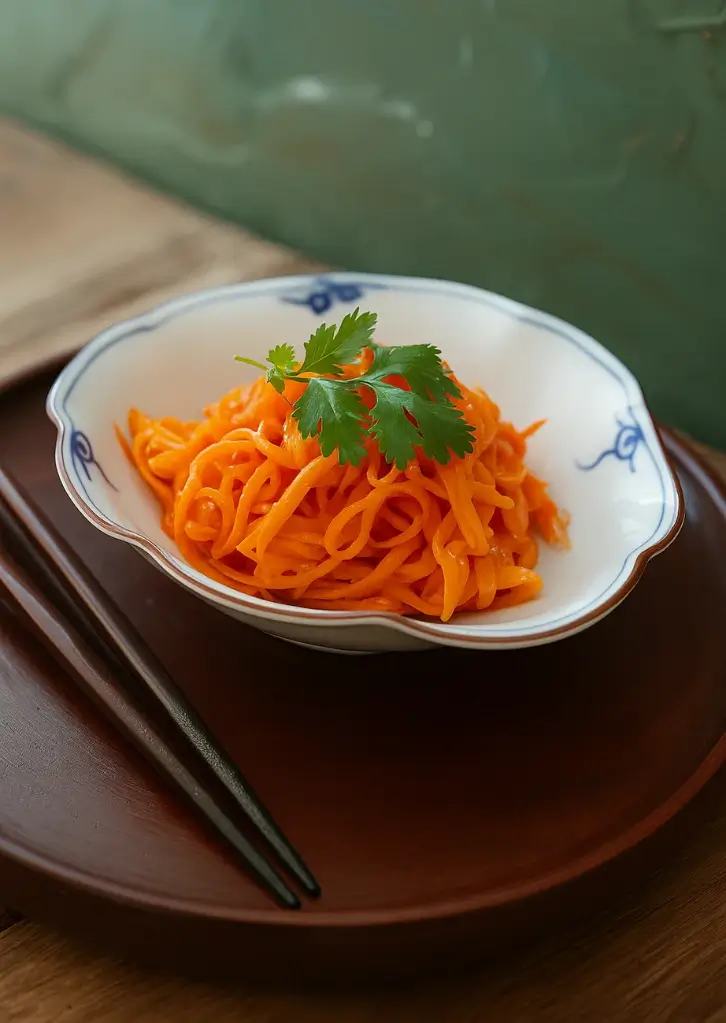
Table of Contents
Why I Love This Korean Carrot Salad Recipe
Growing up in suburban New York, I had never heard of Korean carrot salad until I stumbled across it in a Brighton Beach market. A vibrant pile of julienned carrots glistening in red chili oil caught my eye—and after one tangy, garlicky bite, I was completely hooked. It reminded me of kimchi, but simpler, brighter, and crunchier. Turns out, this dish—also known as Morkovcha—isn’t actually Korean in origin. It was created by the Koryo-saram, ethnic Koreans living in the former Soviet Union, who used carrots instead of cabbage to recreate their beloved kimchi.
That cross-cultural backstory makes me love this recipe even more. It’s a Soviet-era recipe that blends Korean flavors like gochugaru and garlic with Russian pantry staples like white vinegar and sugar. The result? A bold, zesty, and highly snackable tangy spicy carrot salad you’ll want to keep in your fridge year-round. You don’t need fancy ingredients—just a few basics and about 20 minutes. The carrots marinate beautifully, getting more flavorful the longer they sit, which makes this a perfect make-ahead fridge-friendly recipe.
It’s also incredibly versatile. Serve it as a punchy side next to something like our Pollo Guisado or tuck it into a wrap for a crisp contrast. It’s even great with bold bites like air fryer cottage cheese chips or our carrot ribbon salad if you’re going all-in on the root veggies.
Whether you’re new to Korean-style carrots or looking for a kimchi alternative without fermentation, this is one of those recipes that earns a permanent spot in your meal rotation.
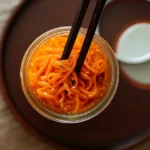
Korean Carrot Salad (Morkovcha): A Tangy, Spicy Soviet-Era Classic
- Total Time: 20 minutes
- Yield: 6 servings 1x
- Diet: Vegan
Description
Korean carrot salad, or Morkovcha, is a tangy, spicy side dish made with julienned carrots, garlic, vinegar, and chili oil. A quick kimchi alternative!
Ingredients
- 1 lb carrot
- 1 tsp kosher salt
- 1 1/2 tbsp sugar
- 2 tbsp white vinegar
- 1/2 tbsp gochugaru (or 1/4 tsp cayenne + 1 tsp paprika)
- 3 tbsp oil
- 1 tbsp minced garlic
Instructions
- Peel and julienne the carrots. Place in a bowl and toss with salt. Let sit for 10 minutes.

- Mix in sugar, vinegar, and chili flakes.
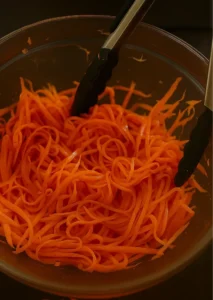
- In a pan, sauté garlic in oil until fragrant, then pour over the carrot mixture.

- Toss everything well and chill for at least 2 hours.
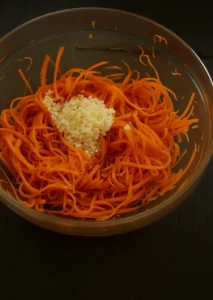
- Serve cold. Store refrigerated up to 7 days.

Notes
Use rice or white wine vinegar for a milder flavor.</p><p>Omit chili flakes for a less spicy version.
- Prep Time: 15 minutes
- Cook Time: 5 minutes
- Category: Salad, Side Dish
- Method: No-Cook
- Cuisine: Korean Fusion, Russian
Nutrition
- Serving Size: 1/2 cup
- Calories: 132
- Sugar: 7g
- Sodium: 451mg
- Fat: 10g
- Saturated Fat: 1g
- Unsaturated Fat: 9g
- Trans Fat: 0g
- Carbohydrates: 11g
- Fiber: 2g
- Protein: 1g
- Cholesterol: 0mg
How to Make Korean Carrot Salad at Home
Making Korean carrot salad is quick, simple, and packed with bold flavor. All you need is a handful of pantry ingredients and a little time for the flavors to come together. This is one of those recipes that gets better the longer it rests—so don’t be afraid to make it ahead!
Prepare the Carrots
Start with fresh, firm carrots. Peel and cut them into thin matchsticks or use a mandoline or a vegetable slicer for consistency. This julienne cut is key—it allows the carrots to absorb the spicy-sour dressing. Place them in a large bowl and sprinkle with kosher salt. Let the salted carrots sit for 10 minutes to soften and release some moisture.
If you love crunchy sides, this Korean carrot salad pairs beautifully with recipes like air fryer veggie chips.
Season the Carrots
Once the carrots have wilted slightly, toss them with sugar, white vinegar, and Korean chili flakes (gochugaru). Can’t find gochugaru? You can substitute ¼ teaspoon of cayenne pepper plus 1 teaspoon of paprika. Mix well until the seasoning coats every carrot strand.
Make the Garlic Chili Oil
In a small saucepan, heat neutral oil (like sunflower or vegetable) over medium-low heat. Add minced garlic and sauté gently until golden and fragrant. Be careful not to burn the garlic—it should be aromatic, not bitter.
Immediately pour the hot garlic oil over the carrot mixture and toss to combine. The sizzling oil blooms the spices and enhances the flavor, similar to techniques we use in our canning jalapeños and other infused condiments.
Let It Marinate
You can enjoy Morkovcha right away, but for best results, cover and refrigerate it for at least 2 hours—or overnight. The vinegar dressing and garlic chili oil will soak into the carrots, deepening the flavor and adding more tang and heat.
This Korean carrot salad will keep in the fridge for up to a week, making it ideal for meal prep or a quick add-on to protein-rich mains like cowboy casserole.
How to Serve Korean Carrot Salad
There are so many ways to enjoy Korean carrot salad, and every one of them brings out its bright, bold flavor. This crisp, garlicky dish isn’t just a side—it’s a total scene-stealer on your plate.
Serve as a Zesty Side Dish
Traditionally, Korean carrot salad—also known as Morkovcha—is served cold alongside heavier main dishes. Its tangy crunch makes it perfect for cutting through rich meats like roast chicken, beef, or pork. If you’re looking for a great main course to go with it, try our juicy pollo guisado. The savory sauce and tender meat pair perfectly with the salad’s sharp vinegar bite.
You can also serve it picnic-style. Add a scoop of Korean carrot salad to your lunchbox next to boiled eggs, pickles, or air fryer veggie chips for a crunchy contrast. It’s a fantastic cold salad option that doesn’t wilt in the sun, making it ideal for summer gatherings.
Use It as a Topping or Add-In
Think beyond the side dish—Korean carrot salad also works as a topping or filling. I love layering it into wraps with grilled chicken or tossing it on top of rice bowls. It adds heat, crunch, and a punch of garlic wherever it lands. Even just a little bit can turn a plain grain bowl into something exciting.
Need ideas for contrasting textures? Pair this salad with air fryer cottage cheese chips or stuff it into a pita with hummus and herbs.
Enjoy It Straight from the Fridge
One of the best parts about Korean carrot salad is that it keeps well and gets even tastier as it rests. Store it in an airtight container, and you’ve got a ready-to-eat snack that’s full of flavor and crunch. I often grab a forkful while prepping dinner—it’s that irresistible.
Whether you’re adding it to a dish or eating it solo, Korean carrot salad brings freshness and fire to any meal. Keep a batch in the fridge, and you’ll always have something crave-worthy on hand.
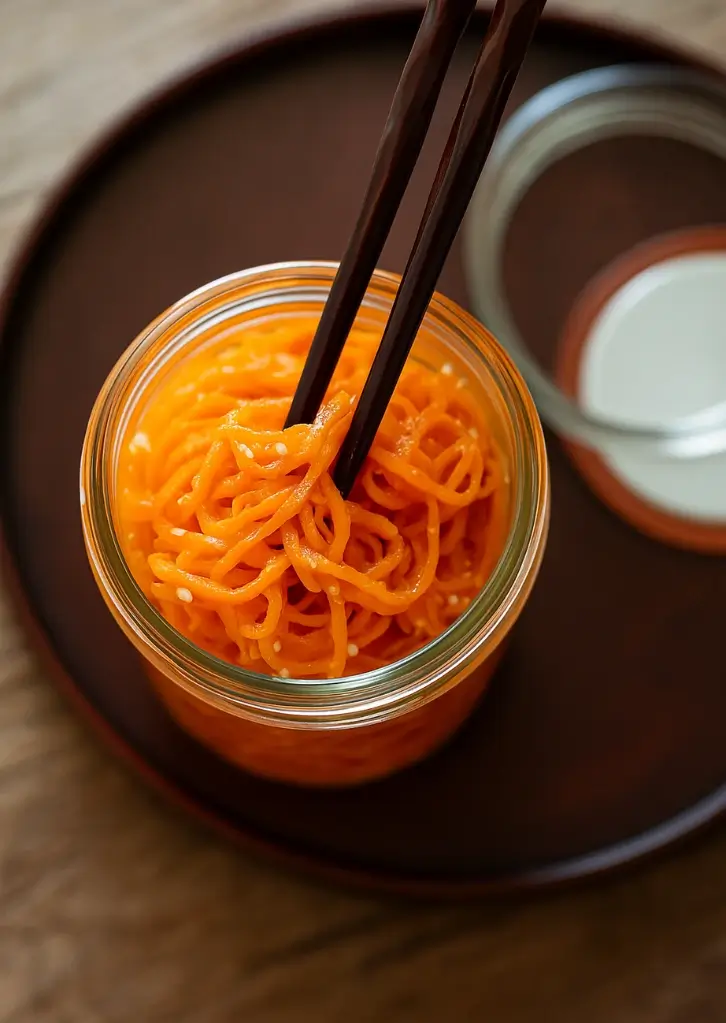
Unique Ways to Customize Korean Carrot Salad
Once you’ve made Korean carrot salad, it quickly becomes one of those dishes you want to personalize. The basic version is simple—carrots, vinegar, garlic, oil, and spice—but it’s incredibly easy to adapt based on your tastes or pantry.
Dialing Up (or Down) the Spice
Not everyone likes the same level of heat. You can skip the gochugaru for a milder version, or go bolder with a pinch of crushed chili or a splash of hot oil. Even a spoonful of sriracha can work in a pinch. If you enjoy heat-driven flavors, check out our canning jalapeños recipe for another spicy option. No matter how you spice it, Korean carrot salad absorbs the flavor beautifully.
Add Crunch or Color
You’re not limited to carrots. Feel free to toss in thin strips of radish, cucumber, or bell pepper for contrast. A handful of sunflower seeds or slivered almonds adds bite. You can also scatter in chopped herbs—think cilantro or dill—for a garden-fresh touch. These variations make your Korean carrot salad even more vibrant and satisfying.
Play With the Flavor Base
A tiny dash of soy sauce can bring out an umami depth, while a touch of honey or maple syrup can mellow the tang. Prefer something savory and rich? A few drops of toasted sesame oil go a long way.
This version of Korean carrot salad also works well in wraps, grain bowls, or alongside heartier fare like cowboy casserole. It plays the perfect tangy, crunchy counterpoint. Try serving it with air fryer cottage cheese chips for a crisp-on-crisp combo.
Choose Your Vinegar Wisely
White vinegar delivers a clean, sharp bite. For a softer profile, use rice vinegar. Apple cider vinegar adds a gentle fruitiness. Just steer clear of anything too dark or sweet, like balsamic—it’ll overpower the dish and dull that signature orange color.
Whether you’re keeping it traditional or adding your own flair, Korean carrot salad is forgiving and endlessly adaptable. With each version, you’ll find new reasons to keep it in your regular rotation. That’s the real magic of Korean carrot salad—it’s never boring, always bold.
How to Store Korean Carrot Salad
If you’re looking for a side dish that holds up well over time, Korean carrot salad is one of the best. It not only stays fresh for days—it actually tastes better after sitting in the fridge. That makes it perfect for prepping ahead or keeping on hand for quick meals.
Best Way to Keep It Fresh
Once you’ve finished mixing the carrots with vinegar, sugar, garlic, and oil, let everything cool slightly. Then scoop the Korean carrot salad into a sealed container and pop it in the refrigerator. After just a couple of hours, the flavors start to blend beautifully. By the next day? Even better.
Unlike leafy salads that wilt or turn soggy, the julienned carrots stay crisp. The dressing keeps working in the fridge, giving each bite more flavor as time goes on. I always make extra so I can enjoy it throughout the week.
How Long It Lasts
When stored in a clean, airtight container, Korean carrot salad stays fresh for up to 7 days. It’s a great go-to when you want something bold and ready-to-eat without cooking. Just open the fridge, grab a fork, and snack away. Want more ideas for chilled dishes that hold up well? Check out our carrot ribbon salad—another crisp favorite.
Always use clean utensils to serve so you don’t introduce moisture or bacteria. If you notice any unusual smell or slimy texture, it’s time to toss it and make a fresh batch.
Can You Freeze It?
Freezing is not ideal for Korean carrot salad. Once thawed, the carrots go limp and lose that satisfying crunch. Since this dish doesn’t need to be warmed up or cooked before eating, you’re better off keeping it chilled and making smaller batches as needed.
Need more make-ahead inspiration? Pair it with long-lasting favorites like our cowboy casserole for a full, fridge-friendly meal.
Frequently Asked Questions
What is Korean carrot salad (Morkovcha)?
Korean carrot salad, also called Morkovcha, is a crunchy, garlicky carrot dish with bold, spicy-sour flavor. It was created by the Koryo-saram—ethnic Koreans living in the former Soviet Union—who adapted traditional Korean seasoning to ingredients available in Russia, like carrots and white vinegar. Today, it’s loved for its bright color, bold taste, and versatility as a side or snack.
Is Korean carrot salad really Korean?
Despite the name, Korean carrot salad didn’t originate in Korea. It was developed by Soviet Koreans as a way to replicate fermented dishes like kimchi without using cabbage or fermenting. The flavor profile is inspired by Korean cuisine, with garlic, chili flakes, and vinegar, but the dish itself is a Soviet-era invention—making it a true fusion recipe.
How do you make Morkovcha?
To make Morkovcha, you start with julienned carrots, salt them to soften, then mix them with sugar, vinegar, and Korean chili flakes (gochugaru). Finally, you pour hot garlic-infused oil over the carrots and let the salad rest to develop flavor. It’s simple, pantry-friendly, and done in about 20 minutes. You can find the full recipe details above in the step-by-step section.
How long does Korean carrot salad last?
Stored properly in an airtight container, Korean carrot salad lasts up to 7 days in the refrigerator. The vinegar helps preserve the carrots, and the flavors deepen over time. Just be sure to keep it cold and always use clean utensils. It’s one of our top picks for fridge-friendly make-ahead meals.
Conclusion
Korean carrot salad is more than just a side dish—it’s a flavor-packed story. With its bold garlic notes, tangy vinegar base, and subtle heat, this salad brings something fresh and vibrant to any table. Whether you know it as Morkovcha or simply that crunchy, spicy carrot dish from the fridge, it’s the kind of recipe that sticks with you.
It’s easy to make, easy to love, and endlessly adaptable. From weekday meals to picnic spreads, from wraps to rice bowls, Korean carrot salad delivers. It’s the kind of fuss-free dish that fits right in with our mission at Easy Peasy Recipes: real food, real flavor, no stress.
If you enjoyed this, check out our other make-ahead recipes, fusion dishes, and vegetable-forward favorites like carrot ribbon salad or cowboy casserole. And don’t forget to bookmark this one—it’s a keeper.
Love Easy, Flavor-Packed Recipes
If you’re enjoying this recipe and want more quick, delicious meals like it, follow us on Facebook and Pinterest for new posts, cooking tips, and behind-the-scenes peeks from my Brooklyn kitchen. We share weekly ideas to make your time in the kitchen easier—and more fun.

